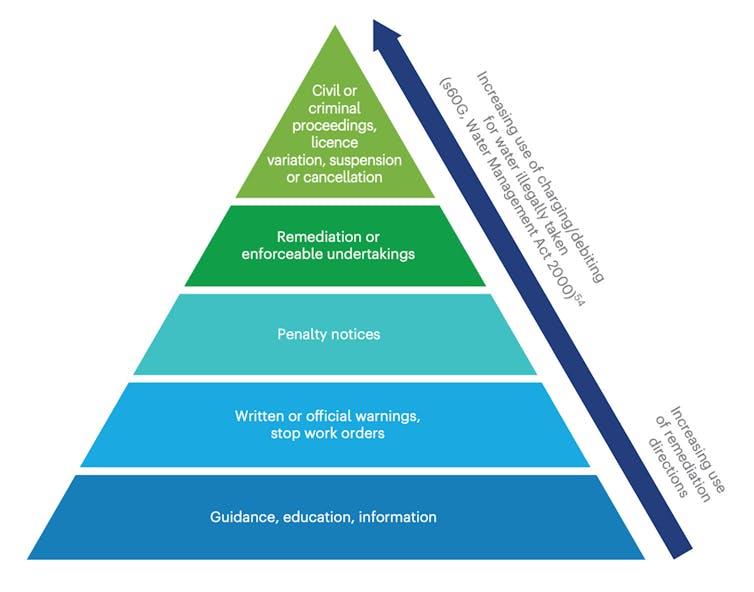Water is one of Australia’s most valuable commodities, worth almost A$100 billion in the Murray-Darling Basin (MDB). But some of that water is being stolen (no-one knows how much) and the thieves usually get away with it.
The federal Labor government came to power promising to improve water use compliance and theft deterrence, while the Inspector General of Water Compliance (IGWC), Troy Grant has also expressed concerns about a lack of compliance and enforcement under inconsistent State laws.
The Inspector General has been given powers to reduce water theft, uphold compliance with MDB rules, and restore confidence among those living and working in the basin. Yet the IGWC was forced to drop 62 cases in February 2023 due to poor state legislative support, inconsistent approaches to water theft, and allowances for some irrigators to balance their accounts in arrears.
Grant has stated that you must be a moron to get caught, and called for urgent action to address inconsistencies in the various state laws that penalise theft from the MDB. That was almost a year ago.
Dropped cases lead to questions about water values, continued supply reliability, the extent of environmental harm, and the future security of water rights. In a study recently published in Nature Water, Environment Institute’s Assoc. Prof Adam Loch and colleagues identified the many relevant laws operating in the basin. They examined these laws and found maximum penalties range wildly. It is exactly as Grant describes it, and we can do better.
If the MDB suffers another drought, as predicted by many researchers including academics at this University, it is likely water theft will become a top concern for all involved, particularly regulators at state and federal levels.
What’s more, if their analysis is correct, available water will dramatically decline in the MDB, possibly motivating more theft. Researchers tested this by combining rainfall and runoff data from the Bureau of Meteorology (BoM) with climate projections from the CSIRO Climate Futures Model and the BoM Water Database to generate a model of future water flows into the southern MDB up to 2100.
Their analysis (Figure 1) shows we’re on track for a water runoff catastrophe by around 2060, and the eventual collapse of the river’s systems by around 2080. Less rain and higher evaporation rates mean less water will runoff the land into streams, rivers, and storages. Sobering stuff.

Figure 1: Actual and predicted future runoff, sMDB 2000 – 2100 using BoM rainfall and runoff data, CSIRO Climate Futures Model Projections and Garnaut Climate Change Review Projections. The figure shows how current trends in expected water supply from runoff in the MDB is trending, with an expected downward trajectory which fits within the original scenario outcome pathways. If this proves true, then future water supply will effectively diminish to a zero-supply status by 2100.
The findings also shows the Inspector General is right: a base comparison of the laws in each state shows clear differences, along with the penalties that sit behind them. Calls for greater certainty and consistency are yet to resonate.
But there were some consistent aspects worth noting, which could help us better understand and analyse the legal framework for penalising water theft in the MDB. This is the “pyramid” approach (Figure 2) to assessing cases and applying penalties, using a tiered framework of increasing severity that looks to be applied universally throughout the basin.
Most MDB states already follow this approach. Yet some states do it better than others.
Still, further inconsistency stems from some States being unwilling to “climb to the top” of the pyramid and initiate court proceedings against the most egregious offenders. This leads to lower penalties in most cases.
Consistency in compliance and certainty across state jurisdictions will help restore confidence in the water market, and ultimately ensure the Murray-Darling’s water flows are protected from thieves. Such penalties may also garner a wider and much needed appreciation of the value of the environment and its services.
But progress has been slow. This is deeply concerning, especially as water flows into the basin will dwindle as the climate changes. We are hoping that this research will alter those views and encourage change needed in this space. Next steps are to continue our in-depth review of cases and outcomes to better inform those changes.

Figure 2: NRAR mitigating issues and penalty escalation framework [31, pg. 9]. The process shown outlines how the NRAR seeks to arrive at the case assessment process and how best to place any penalties for infringement into the decision. This only applies in New South Wales.
Further reading:
Link to The Conversation article: Water theft laws and penalties in the Murray-Darling Basin are a dog’s breakfast. Here’s how we can fix them.
Loch, A., Croft, M., Adamson, D. and Giancaspro, M. (2024). Assessing effective deterrence of theft in transboundary water systems. Nature Water, pp.1–10. doi:https://doi.org/10.1038/s44221-024-00223-8.
Written by Associate Professor Adam Loch, Centre for Global Food and Resources, School of Economics and Public Policy, Faculty of Arts, Business, Law and Economics, University of Adelaide.











